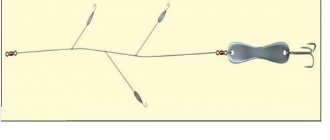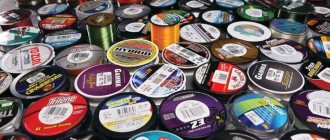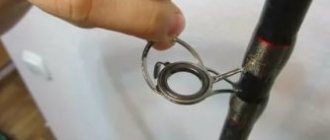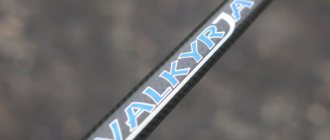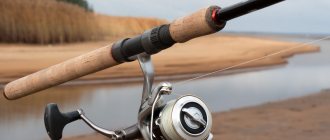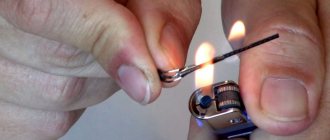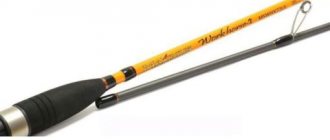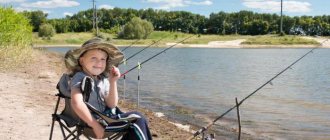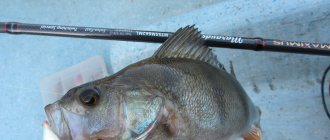The structure of the rings
Pass-through rings
The pass-through ring consists of a frame and an insert that is glued or rolled into it. Frames and inserts are made from durable, corrosion-resistant materials with low specific gravity, because the weight of the guide rings affects the structure of the rod, especially ultra-light and light spinning rods, in which the total weight of the rings is commensurate with the maximum permissible weight of the bait.
Passage ring frames
The frame is determined by the total horizontal length, height and diameter, length and number of legs. The combination of these characteristics, taking into account the fact that the shape of the frame itself can also be different, gives a huge number of possible combinations. However, not all of them are of practical importance.
The type of frame (as well as the type of insert) is primarily determined by the purpose of the rod, not only the fishing style (including the type of water - fresh or salt), but also such characteristics as action and recommended weight of the bait. The frame is made of steel or, much less commonly, of titanium (in this case, the first letter in the ring article number is T). Titanium rings, for example, are used in the “Legend Elite (St. Croix)” model, which is quite justified, since these rods use a completely new type of carbon fiber, which is 15% lighter than analogues made using previous technologies, so it makes sense not to lose This is an achievement, because Fuji titanium is 35-45% lighter than steel. And on the “Titanium 2000” (Lamiglas) rod, which uses the technology of butt-butt splicing of titanium and carbon fiber material in order to radically enhance sensitivity (the titanium part works as a resonator), “Fuji SiC” rings with a steel frame are used.
According to the most reputable rod manufacturers, the choice of rings is dictated not by the desire to give the rod respectability (for them this issue has long been resolved), but by strict functional validity. No titanium, no inserts into the frame will improve the performance of a rod with an average quality whip, but correctly selected guides can contribute to its ideal performance. Therefore, it is extremely short-sighted to choose a rod based only on the rings - you may end up with a rod that is very average in the quality of the whip, but claims to be of a high class.
The frame can be painted, however in recent years steel frames containing SiC inserts have not been painted as it has been found that the effort and time required to do so is not comparable to the resulting benefits. Therefore, the ring frame with SiC insert has the natural color of blackened steel.
The type of frame largely determines the use of the ring, therefore next to the article number a recommendation for its use is given. If you want to change the guides on your fishing rod, then you should pay special attention to these recommendations, as they are based on extensive experience.
Most often the insert is simply inserted into the frame and protrudes slightly on both sides. However, there is a type of insert that we call “pouring”.
In this case, the edges of the insert are rolled, and the frame is practically invisible; the line does not come into contact with the frame and, therefore, does not rub against it during any bending of the rod. This technology is quite complex on thin rings, since the frame itself must also be very thin. The surface of a thin insert is more difficult to process, and the frame and insert must be connected as firmly as possible. Only a few manufacturers are able to resolve this set of issues at the proper level.
Pass Ring Inserts
Materials primarily used in the production of inserts include titanium nitride coated metal ceramics (Gold Cermet), silicon carbide (SiC), aluminum oxide and porcelain. However, in reality there are 8 types of inserts: “Gold Cermet”, SiC, “Alconate”, “Hardloy”, “Hard Ring”, “O”, “Hard”.
Insert materials, as a rule, differ in 4 main parameters: hardness (Vickers), density, thermal conductivity and bending strength. SiC has the highest thermal conductivity.
With low thermal conductivity, the line friction insert heats up at one critical point due to poor heat dissipation. This damages the insert and the adhesive that holds it in place, which may result in the insert falling out of the frame. With SiC inserts, heat is distributed smoothly and quickly throughout the entire insert and frame, which eliminates such troubles. However, “Gold Cermet,” whose thermal conductivity is lower than that of SiC, gains points, since the titanium nitride coating itself is quite reliable, and the bending strength is 2 times greater than that of SiC. Strengthened aluminum oxide "Alconate" or "Hardloy" compensates for lower thermal conductivity with higher hardness, but they are heavier. This leads to the conclusion: it is impossible to achieve the maximum in all respects at the same time; something will have to be sacrificed (including your wallet). That is why it is possible to determine which rings are needed only on the basis of the characteristics of the fishing rod and the methods of its use.
Over time, you can learn to distinguish the type of insert from a particular manufacturer by color shade. But, as mentioned above, you need to be sure that this is not just a superficially identical copy. The brand of rings and type of insert are indicated in the rod manufacturer's catalog.
The number on the ring is not the inner diameter of the insert, but the inner diameter of the frame into which it is inserted. That is why, depending on the insert, rings of the same size have different internal diameters.
Description of design
The pass ring consists of a frame and an insert. The mass of throughput parts has a direct impact on the whip. Ideally, the rings should have a slight heaviness. Therefore, these parts are made from corrosion-resistant material with a low specific gravity.
Depending on the purpose of the fishing rod (manner of fishing, nature of the water, weight of bait), there are different types of frames and inserts.
Steel rings have many negative aspects: frames that rust, inserts that wear out and crack, and difficulty in polishing. One plus is that they are cheap. But this price is not worth this quality.
Frames are made of steel or titanium (less commonly). For titanium ones , a new form of carbon fiber is used, making them 30-40% lighter. Titanium rings are designated by the letter T. They are used in models such as the “Legend Elite (St. Croix)”. To significantly increase susceptibility, a technique is used to tightly connect titanium and carbon fiber, for example, “Titanium 2000”, which uses a Fuji SiC steel frame.
Frame options:
- diameter;
- horizontal extent;
- height;
- number of legs;
- form.
In the manufacture of inserts, metal ceramics coated with titanium nitride, silicon carbide, aluminum oxide and porcelain are used.
There are 8 insert options available: “Gold Cermet”, SiC, “Alconate”, “Hardloy”, “Hard Ring”, “O”, “Hard”.
They differ in significant characteristics:
- hardness;
- density;
- thermal conductivity;
- bending strength.
Comparative characteristics:
SiC inserts are characterized by uniform heat distribution throughout the entire element. This property eliminates heating in one place.
In “Gold Cermet” the thermal conductivity is less, but the titanium nitride coating is quite resistant and the bending strength is twice as significant.
“Alconate”, “Hardloy” have high hardness, thereby being heavier, but have lower thermal conductivity.
The type of insert from each manufacturer differs due to the color shade, but you need to make sure. The brand of rings and type of insert are noted in the spinning rod manufacturer's journal.
Installation and replacement of access rings
Also important is how the guide rings are installed on the spinning rod or if you need to make a replacement. The same form, depending on the location of the rings and their number, can be either faster or slower in formation. Of course, this is somewhat arbitrary, since first of all the structure of the rod depends on the blank itself, but you should not underestimate the correct installation of the guide rings. On a good and high-quality spinning rod, they are always installed along the inner seam line on the whip. Most fishermen do not even suspect the existence of such a seam, since it is not visible to the eye. This is a purely technological seam, and it is present in almost all, even the most expensive, fishing rods.
If you look at the whip in cross section, it turns out that the wall thickness is not the same everywhere. An obvious thickening of the wall noticeable to the naked eye is a technological seam. It is quite obvious that any whip will have the greatest possible rigidity along the seam line, and if they stand along it, then this is an indicator of the good build quality of your fishing rod. For the first time, the issue of the importance of installing guides was raised by the famous German fly fisherman H. Schneinfort.
You can check the correct installation or replacement of pass rings in a very simple way. The assembled fishing rod is taken with one hand next to the tulip, and with the other 30-40 cm below. Next, you should slightly bend the tip of the spinning rod and begin to slowly rotate it around its axis. At some point it will seem to slip and escape from your fingers. This slippage occurs when the rod is bent along the seam line. It is in this position that you need to fix the tip of the rod and look at where the pass circles are. If their location is strictly below or above relative to the whip, then the rod is ideally assembled and is perfect for jig-spinning, since its rigidity is maximum. If they are positioned strictly to the side at 90 degrees, no matter left or right, this means that they are positioned along the softest line of the rod. This may not mean that they were installed incorrectly, but rather indicates that, most likely, the manufacturer’s goal was to make a fishing rod with a slower action (of course, in the marking it is not designated as fast, which clearly indicates careless assembly) . But if in the same position of the spinning rod they are located completely arbitrarily, and not vertically or horizontally, then choosing such a rod can be compared to purchasing a time bomb.
Firstly, with such a spinning rod it will be almost impossible to make accurate long casts, since the tip of the rod will move back and forth not in a straight line, but along a complex and unpredictable trajectory. And secondly, at the moment of playing fish or simply bending under a relatively small load, the whip is greatly deformed as a result of the action of twisting forces. This very quickly leads to the destruction of the spinning rod material, which gradually peels off, as it is designed for longitudinal bending, and not transverse torsion. The fatigue of the rod arising from such loads can accumulate in just a couple of months of active fishing, and sooner or later the fishing rod will literally fall apart for no apparent reason at the time of casting, hooking or retrieving.
You should also pay attention to the diameter of the pass ring closest to the reel. If it is small and you are fishing with a spinning reel, then your casting distance will suffer. Therefore, when choosing a fishing rod, be sure to pay special attention to this point.
Video: replacing guide rings
Design Features
It is no secret that other fishermen with extensive experience, if necessary, make spinning rings with their own hands, using various hard metals and composites. But nowadays this is, rather, an exception to the rule , since on sale you can find a lot of high-quality new rings from various manufacturers. Now they are made from modern materials that must meet the following requirements:
- be durable and wear-resistant;
- have excellent corrosion resistance;
- be as light as possible, because their weight affects the weight, and, consequently, the quality characteristics of the entire rod.
The design of good rings consists of two elements: a strong, wear-resistant insert and its frame (frame), which is attached to the blank body on one or two legs. Moreover, frames on two legs only have frames on particularly strong spinning rods , and then only the first three or four rings. The remaining passage rings are mounted on one leg; modern structural materials allow this to be done without a significant reduction in their strength, but with a significant reduction in the weight of the fasteners.
A good angler should know the basic quality characteristics of frames. This:
- Number of mounting legs.
- Frame height.
- Total length.
- Frame diameter.
Nowadays, the strongest and lightest frames are made of titanium .
Modern inserts, which are in direct contact with the fishing line and are located inside the frames, are made of three materials:
- Made from aluminum oxide ( Al2O3 ).
- Made from silicon carbide ( SiC ).
- From any light metal on which a surface coating of a particularly strong alloy is applied, for example titanium nitride.
Various rings made of durable metal or porcelain , which used to be very popular, are no longer used .
You need to know that aluminum oxide rings can be used if you use regular monofilament . When using braided cords , it is better to choose a spinning rod with more wear-resistant rings .

